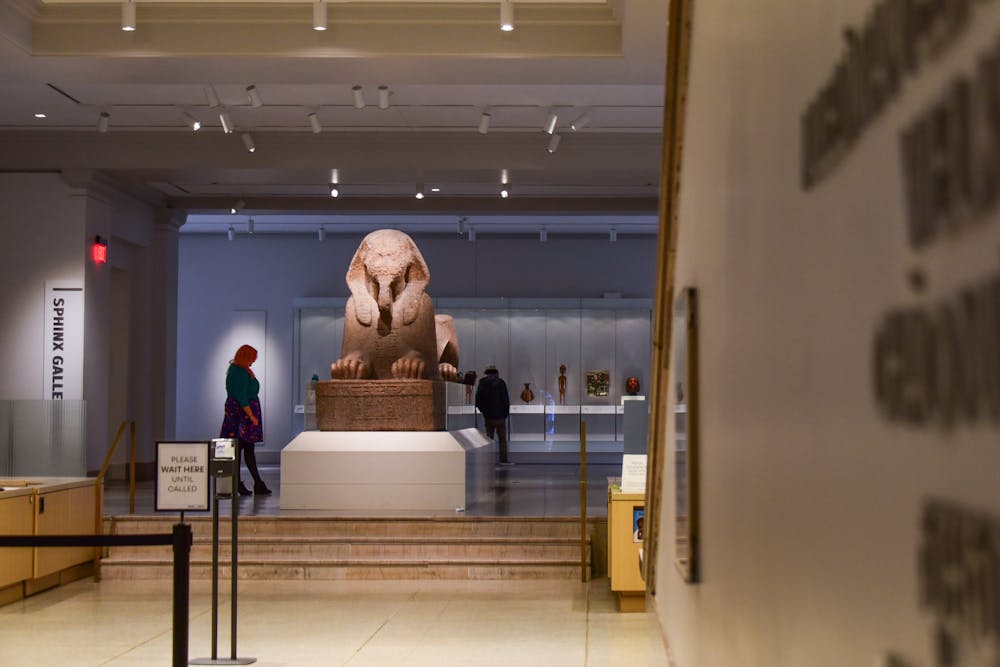
Editor's Note: This article has been updated to clarify that human remains in the Morton Collection were kept, not showcased, and corrected a misleading claim concerning Penn Museum’s communication of possession of remains from the MOVE bombing. This article also now provides information on additional discounted admissions opportunities at the Penn Museum. The DP regrets these errors.
It costs $18 to visit the Penn Museum.
The general admission for adults may seem like pocket change to some, but is a luxury for many. Families that are trying to save money will not see dropping close to twenty dollars per person ($16 if you’re 65 and older, $13 if you’re 6-17 or a college student) as a great deal for a fun weekend activity.
Penn is proud of its supposed commitment to local engagement, even noting that one of its goals is to improve public education in Philadelphia. Although the school participates in many initiatives that do address this, it seems that the high admission prices by the Penn Museum clashes with its dedication to education improvement as the financial barrier of the tickets discourage residents from visiting the museum and learning. In fact, by placing a dollar sign on the knowledge inside of the Penn Museum, Penn reinforces the idea that certain higher forms of knowledge are reserved for only the people who can afford it.
The education system has always favored the rich — through grades K-12, students from a higher-income background have wider access to better quality education (better schools, tutors, at-home study resources…the list goes on and on). Due to these privileges, these students have a greater chance to get into elite centers of education such as Penn, with around 45% of Penn students coming from the top 5 percent, and 19% coming from the top 1 percent. Here, students again have access to an exceptional education, with the school offering undergraduate research opportunities, career advising, world-renowned faculty, and generally an immense amount of resources for no cost; for instance, the Penn Museum is free for Penn students. Once graduated, students from elite universities continue to perpetuate the division of wealth present in our society, with 50% of full-time jobs among recent Penn graduates being one of the highest-grossing careers: finance and consulting.
Although there is nothing wrong with earning money and investing in a good education, it is apparent that students from low-income families do not have the same starting point as children from more privileged backgrounds. Because lower-income students’ access to education resources is limited by financial factors, they often have to work twice as hard to end up in the same places of learning as the wealthy. For example, while around of students from wealthy backgrounds who scored at the 99th percentile on the SAT or ACT attend an "Ivy-plus college" (the Ivy League along with MIT, Stanford, Duke, and the University of Chicago), only 20% of low-income high-schoolers in the same standardized test range do so as well.
Simply, the fees presented by the Penn Museum reflect how the financial gate-keeping of knowledge can instigate a prevalent side-effect in many exclusive universities and education systems — the existence of an intellectual elite.
However, it is important to recognize that the Penn Museum does have opportunities for people to save money. Teachers, active duty military members, veterans, children under six, and patients and families of Penn Medicine or the Children’s Hospital of Philadelphia can visit for free all year long. Furthermore, there’s free admission for teenagers and college students during select times. ACCESS and EBT cards, approved for individuals receiving public assistance, provide $2 admission to the cardholder and three guests to cultural sites such as the Penn Museum. Although all these amazing benefits have begun the process of tearing down financial barriers for certain people, the wall still stands. Let us take it apart brick by brick. In other words: the Penn Museum should be free for all residents of Philadelphia regardless of age, career, or day of the week.
Why? The Penn Museum is an important place. It builds upon a cultural foundation of knowledge for everyone and cultivates a greater understanding of humanity. Museums teach us not only facts, but humility, showing us that the universe is so much bigger and society so much older than we recognize on a daily basis and inspiring us to ask more questions and find more answers. By opening its doors wider, the Penn Museum could encourage more people to explore what the world has to offer.
Additionally, the Penn Museum profited, both intellectually and financially, from the tragedies of the Philadelphia community for years. No one will forget how the museum unethically kept the remains of at least one child killed by the 1985 bombing of the MOVE community by the Philadelphia Police, or how they kept the human remains of at least 20 Black Philadelphians in the Morton Collection. Providing the Philadelphia community free access to the museum’s knowledge should not concern an institution that felt at enough liberty to take and present the knowledge, without any consideration of its ethics, that belonged to the same community.
Written apologies are not enough. It is time for the Penn Museum to put its money where its mouth is and begin repatriating the citizens of Philadelphia, starting with free admission into the galleries.

CHLOE CHEN is a College first-year from Vancouver, Canada. Her email is chloeec@sas.upenn.edu.
The Daily Pennsylvanian is an independent, student-run newspaper. Please consider making a donation to support the coverage that shapes the University. Your generosity ensures a future of strong journalism at Penn.
Donate




